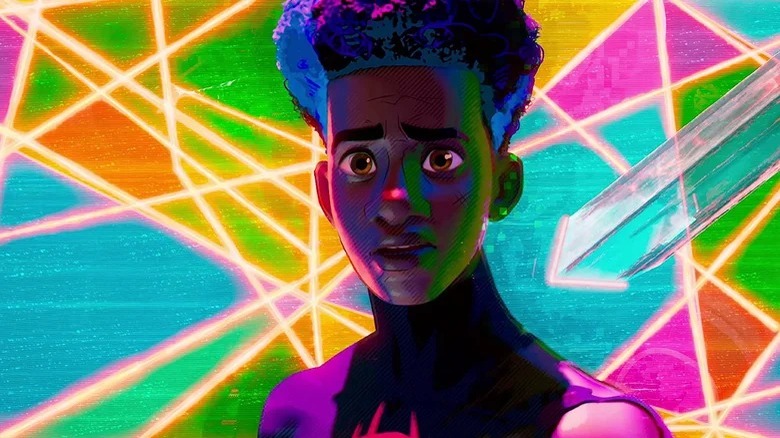Spider-Man: Across The Spider-Verse Echoes Everything Everywhere All At Once
This post contains spoilers for "Spider-Man: Across the Spider-Verse."
When it comes to practicing empathy and understanding diverse experiences, the multiverse is the perfect fictional sandbox in which storytellers can explore. Wisdom dictates that seeing more of the world makes most people more empathetic and understanding of one another, so what happens when characters get out and explore the worlds? The answer is something like "Everything Everywhere All At Once," last year's Best Picture Oscar winner and a film that uses the everything-ness of its title to tell a story that's at once massive and personal. Profound and empathetic, with an awe-inspiringly wide-ranging scope and visuals to match, "Everything Everywhere All At Once" is unlike any other movie.
Phil Lord and Christopher Miller's "Spider-Verse" films are a little bit like it, though. Miller said as much in an interview with Empire earlier this year, noting that the films' success hinges not just on spectacular visuals and world-hopping, but on the soulful story at the film's center. "With our movies, it's similar to what the Daniels did in 'Everything Everywhere All At Once,'" he noted. "You can have all the spectacle and action and visual insanity, but it has to be focused on an emotional journey you feel in your heart."
A multiverse-spanning story about parents and kids
"Spider-Man: Across the Spider-Verse" certainly focuses on that emotional journey. While it's not as much of a tearjerker of the story of exacting Evelyn (Michelle Yeoh), her underappreciated husband Waymond (Ke Huy Quan), and their rejected-feeling daughter Joy (Stephanie Hsu), the dual tales of Miles Morales (Shameik Moore) and Gwen Stacy (Hailee Steinfeld) are still emotional. In the sequel film, which is part one of a two-part story, it's Gwen who gets a complete arc as she reckons with her policeman father's awful reaction to learning she's Spider-Woman. Time apart eventually softens his heart, but she spends much of the film feeling displaced and anxious about her support system after her "coming out" was met with a threat of violence.
Despite the superheroic circumstances, there's plenty worth relating to in Gwen's story, especially for any kid who's ever been rejected by a parent. Gwen doesn't even have to tell us how she feels: the ever-shifting watercolor world she lives in does it for us. Miles' arc, though incomplete, also grounds the film's fantastic visuals. While he seems mostly oblivious to the repercussions of his actions in a typical teenage boy fashion, we understand the coming-of-age dilemma he's facing through the eyes of his mother. Rio (Lauren Vélez) can foresee every single way the world might try to stymie the spirit of her Afro-Latino son, and has to let go of her own fears about his future in order to let him grow.
Eye-popping visuals abound
Both parent relationships here carry echoes of Evelyn and Joy's relationship in "Everything Everywhere All At Once." Though that's coincidental, it speaks to the way storytellers like Lord and Miller and the Daniels can focus our attention on the beauty and specificity of experience by surrounding one story with overstimulating chaos that mimics the feeling of life on overdrive. While the emotional cores of "Spider-Verse" and "Everything Everywhere All At Once" share some similarities — particularly, the parent-child relationships of families of color living in America — the films' visuals are in even stronger kinship.
The latest "Spider-Verse" film uses six distinct art styles (plus plenty more used on individual Spidey variations) to bring its multiverse to life, and the film isn't afraid to flit between them second to second — or even frame to frame. The experience of watching "Spider-Man: Across the Spider-Verse" often feels a lot like watching the rapid-fire universe-hopping scenes in "Everything Everywhere All At Once," when for a moment, Evelyn suddenly becomes an urn, a cat, or a pinata. The "Spider-Verse" version of this doesn't change Miles, but allows for a visual clash between the many worlds on display, most often when the dozens of Spider-People he meets come together.
"Spider: Man Across The Spider-Verse" is as different from "Everything Everywhere All At Once" as it is similar, but both are wildly, endlessly creative takes on the multiverse – and the human heart. As Miller notes, the mind-blowing visuals of "Spider-Verse" wouldn't work without the emotional journey, and thankfully, they don't have to. The story of Mile Morales is endearing and captivating, and it works in perfect tandem with the groundbreaking visual art that makes the "Spider-Verse" series new classics in the making — just like another Oscar-winner we know.
"Spider-Man: Across the Spider-Verse" is now in theaters.


